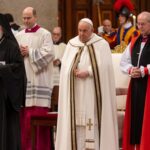Justin Brierley recently republished his Easter 2024 article about a possible Christian revival in the UK. I appreciate the way he tries to avoid both cynicism and naivety. He does this by combining ‘centred-set’ and ‘bounded-set’ approaches, and this is informative for evangelism in our current cultural context.
Brierley recounts the now-widely-recognised existential vacuity and consequent collapse of aggressive atheism, and commensurate revival of interest in religion, spirituality, personal moral virtue, and communal solidarity. He also points out the limitations of this possibly incipient revival. He critiques Jordan Peterson’s psychological reinterpretation of Christianity, and evolutionary biologist Bret Weinstein’s similar reduction of Christianity to ‘true metaphor’, as being inconsistent with Christianity’s claims to be grounded in historical facts, especially Christ’s physical resurrection. He similarly critiques weaponising Christianity as a tool of the culture war against the ‘woke’ or radical Islam.
True Revival and Faith in the Physical Resurrection of Jesus
Brierley recognises that Christianity’s vitality cannot spring from a communally responsible but still anthropocentric morality (as seen, for example, in Jordan Peterson or Louise Perry), nor an imprecise religious or supernatural disposition (see for example Joe Rogan and Douglas Murray). The unique nature of the Christian faith springs from its foundation on the historical, and therefore witnessable, expression of the supernatural in the life, death, and resurrection of Jesus Christ. Brierley reasserts the historical credibility of Christianity’s truth-claims and the need to accept those truth-claims for authentic faith and Christian identity:
If it isn’t literally true, it isn’t valuable. Whether Jesus Christ actually rose from the dead matters. It mattered to St Paul… it should matter to us.
Centred Sets and Bounded Sets
Brierley simultaneously represents the Godward yearnings of these significant public figures in a sympathetic way, as honourable searches for ultimate truth. And this is where he uses the sociological concepts of ‘centred’ and ‘bounded’ sets. With a centred set, what matters is direction. Are people moving towards or away from the centre? With a bounded set, what matters is the boundary. Are people in or out? Paul Hiebert introduced the concepts to missiology many years ago. They’re now familiar enough to be woven into significant ministry texts like Tim Keller’s Center Church and into fellowships like The Gospel Coalition—see here and here.
Brierley invokes bounded sets in his recognition that credible Christian identity is not infinitely malleable but possesses definable content:
If people hadn’t actually believed in the Christian promise of redemption and if they hadn’t been able to hope in the face of death, they wouldn’t have had the courage to change the world in Jesus’s name.
Definite content implies boundaries. Anyone can call themselves Christian. But for that self-identification to be true before God and humans, people have to believe certain things. Those beliefs place them either inside or outside the church. This is the tradition of Christian orthodoxy. The New Testament itself contains creedal, confessional formulae—particularly Philippians 2:5–11 and 1 Timothy 3:16, which may have been repeated in church meetings or used as professions of faith.
That tradition of orthodoxy continued in the early church’s production of the three great ecumenical creeds—the Apostles’, Nicene (which is 1700 years old this year!), and Athanasian. It was also expressed in the great post-Reformation confessions: the 39 Articles of Anglicanism; the Westminster Standards of Presbyterianism; The (Second) London Baptist Confession; the Congregationalist Savoy Declaration; and the Three Forms of Unity of the Continental Reformed churches: the Belgic (French) Confession, the Heidelberg Catechism, and the Canons of Dort. The Gospel Coalition has numerous resources on these creeds, confessions, and catechisms.
Inquirers Start from Somewhere Through Some Connection
Brierley nevertheless demonstrates an admirable hospitality towards people who appear to be honestly seeking Christ. He applies a centred-set approach in his recognition that such inquirers start their journey towards Christ from somewhere, through some connection with Christ and/or the church. He is willing to patiently journey with them towards Christ.
In a previous era of the (nominally) ‘Christianised West’, the ‘place’ they came from and the ‘road’ they took towards Christ were more predictable. The issues and objections that apologetics and evangelism needed to address were similarly predictable. Both tasks could be conducted in consistent ways.
But the decline of Western cultural acceptance of and knowledge about Christianity means that contemporary seekers will arrive from all kinds of inconsistent, potentially contradictory places, and come through unexpected ways. What made (formerly) atheist historian Tom Holland open to Christ? Not rational arguments about the historical credibility of Christianity. It was a mystical experience precipitated by an icon of Mary, and an experience of a possibly miraculous healing from cancer in answer to a prayer to Mary. Brierley similarly observes that “many people in the pews” of Holland’s church are probably “turning up for a mystical encounter” mediated by the “blend of sacred choral music, candlelit arches and incense-infused worship” that church offers.
But Brierley expects seekers to recognise the idiosyncratic and eccentric nature of such beliefs. Holland freely admits that his experiences have “affected him” but does not expect them “to sway a hard-headed sceptic.” He also admits his experience of healing as “answered prayer… won’t fit neatly into every Christian box either.” Of course inquirers believe unorthodox things—they’re not Christians, they’re not within the bounded set yet! But, in contrast to the overweening arrogance of the now not-so-New Atheists, they at least have the open-minded humility to consider centring their life on Christ.
Centred-Set Hospitality
I’m less optimistic than Brierley that a rebirth of belief in God in general is the same as, or even a precursor to, a revival of Christianity in particular. But I think his combination of bounded and centred set approaches is a useful example of how to engage this new openness towards the supernatural. We can show an interest in where people are coming from. What do they already believe about God/the gods/the supernatural realm? Why do they hold these beliefs? And we can ask them about how they became interested in Christ and what led them to visit our particular church or para-church ministry. What has made them stop ignoring Christ and turn towards him instead? What has motivated them to journey towards Jesus as far as they have?
We don’t have to agree with everything that inquirers already believe. They don’t expect us to. What this kind of centred-set hospitality does expresses is the reality that we are both on a journey towards Jesus. Christians who have stepped ‘inside’ the boundary are further along the journey than inquirers who have just begun. Inquirers know that. That’s why they’re asking us for directions. And the fact that we are further along the journey gives us credibility to draw boundaries in ways which demonstrate the value of those boundaries in our journey towards Jesus. If inquirers are really interested in the real Jesus, then they’ll be willing to know what the Bible really says about him.
Stepping Inside the Boundary of Orthodoxy
The Bible sets out certain requirements for authentic Christian identity, which the church has systematised as particular doctrines: belief in God’s existence as the one benevolent almighty universal Creator and our consequent responsibility towards him; the depth of human sinfulness rendering us unable to repair our relationship with God; Christ’s two natures as God and sinless human; his atoning sacrifice as the only means of reconciliation with God; his physical resurrection as ruler over the universe and unique possessor of eternal life with God; his return to judge and renew the world; and the two destinies of humanity in either eternal joy or misery.
Anyone who really wants to journey towards the real Jesus needs to appropriate these beliefs to themselves. Honest belief in these supernatural realities is authentic Christian faith—it puts you inside the boundary of the church. Our continued journey towards Jesus consists in a deeper appreciation of these doctrines and others implied by them—such as the specifics of the Trinity, divine sovereignty, election and predestination—and the effort of constantly aligning our lives to these supernatural realities.
The different places inquirers are coming from and the different roads they’re taking may throw up all kinds of obstacles which restrain them from truly committing to Christ. But by God’s grace they may provide all kinds of useful contact points as well. By “accept[ing] that there are angels,” Holland has moved closer to reality than those who deny the reality of the supernatural due to their dogmatic materialism. His sense that such a (re)enchanted world “seems richer and more interesting” is therefore right. But is he willing to accept the superiority of the Son over the angels (Heb 1) and embrace the great salvation he has achieved for us (Heb 2:1–4)?
The ‘vibe shift’ which seems currently underway in Western culture will offer, as every era does, opportunities for and challenges to the gospel. Brierley shows us how we can combine centred and bounded-set approaches to recognise the diversity of people’s backgrounds and interests in the gospel and use those diverse particularities to urge people to wholeheartedly commit to Jesus, who alone is the way, the truth, and the life.
















